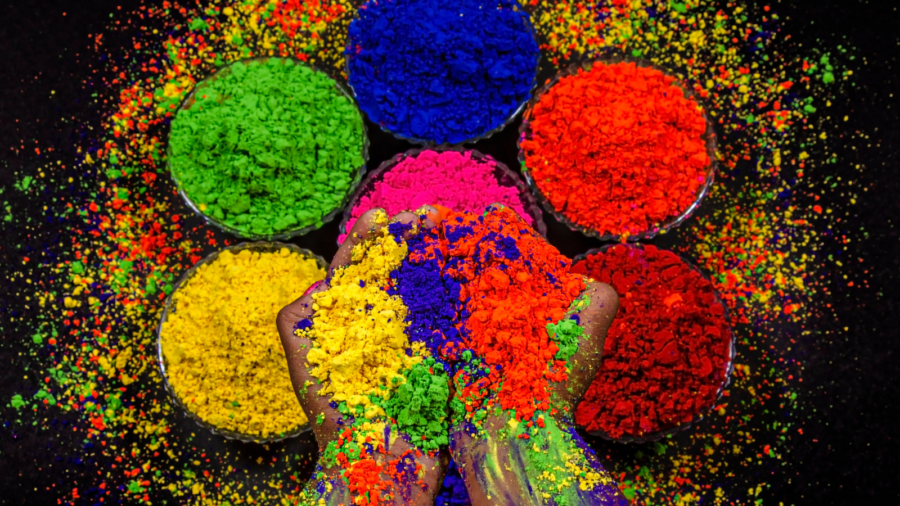Introduction:
Holi, one of the most exuberant festivals in India, is a vibrant celebration that brings streets to life with vivid colors and infectious energy. As people come together to rejoice in a riot of red, green, yellow, and blue hues, Holi marks the arrival of spring and signifies the triumph of good over evil. Beyond its religious roots, Holi embodies the spirit of unity, forgiveness, and the pure pleasures of life.
Exploring the Origins and Significance:
The origins of Holi are steeped in mythological folklore, with the tale of Prahlad and Holika being one of the most renowned. Prahlad, a devotee of Lord Vishnu, was rescued from his wicked aunt, Holika, through the divine intervention of Lord Vishnu. This victory of righteousness over malevolence is commemorated on the eve of Holi through the ritual of ‘Holika Dahan.’
Another captivating legend linked to Holi is the mischievous behavior of Lord Krishna, who initiated the tradition of smearing colors on his beloved Radha and her companions. This playful essence of Holi adds to its jubilant and lively atmosphere.
Preparations and Festivities:
Weeks before the festival, markets buzz with activity as people purchase colors, water guns (pichkaris), and delectable sweets in preparation for Holi. On the day of the festival, individuals congregate in open spaces, streets, and parks armed with buckets of colored water and packets of powdered colors (gulal).
The festivities commence with the ceremonial ‘Holika Dahan,’ where bonfires are lit symbolizing the victory of good over evil. Participants gather around the bonfires, sing folk songs, and partake in rituals to dispel negative energies.
The real enjoyment begins the following day as the streets transform into a kaleidoscope of colors. Friends, families, and even strangers come together to playfully drench each other in colors, spreading joy and laughter. Water balloons and pichkaris add to the festivity as individuals gleefully chase each other, splashing colors with abandon.
Cultural Diversity and Regional Traditions:
Holi transcends regional and cultural boundaries in India, with each region adding its distinctive touch to the celebrations. In states like Uttar Pradesh and Bihar, particularly in the north, Holi is observed with grandeur. The traditional folk songs of the ‘Braj’ region lend a melodious charm to the festivities.
In Gujarat, located in the west, Holi assumes a spiritual essence with the observance of ‘Rangwali Holi’ at the Dwarkadhish Temple in Dwarka. Here, priests and devotees bathe the idols of Lord Krishna and Radha in colors, marking a spiritual connection.
Celebrating the Vibrant Festivals of Holi in India: A Joyful Spectacle
In Tamil Nadu, a southern state, Holi coincides with the harvest festival of ‘Pongal’ and is celebrated as ‘Kama Dahanam,’ symbolizing the symbolic burning of the God of Love, Kama, by Lord Shiva.

Delightful Feasts and Sweets:
No Indian festival is complete without a culinary indulgence, and Holi is no exception. Traditional Holi delights like gujiya, a sweet dumpling filled with khoya (thickened milk), dried fruits, and sugar, are lovingly prepared in every household. Other popular treats include thandai, a refreshing concoction made with milk, almonds, saffron, cardamom, and puran poli, a sweet flatbread stuffed with lentils and jaggery.
The spirit of Holi extends beyond feasting, as people exchange sweets and treats with neighbors and loved ones, spreading warmth and happiness.
Fostering Social Harmony and Forgiveness:
Holi’s beauty lies in its ability to bridge social divides and promote harmony among people from diverse backgrounds. On this day, grudges are set aside, and adversaries become allies as everyone unites in the colorful revelry.
The egalitarian nature of Holi is epitomized by the tradition of ‘bhang,’ a cannabis-infused beverage consumed liberally during the festivities. Irrespective of caste, creed or social status, partake in this intoxicating elixir blurring societal distinctions.
Environmental Consciousness:
While Holi is a time merriment it’s crucial to observe it responsibly, considering its environmental impact. In recent times, there has been growing awareness about the adverse effects of synthetic colors containing harmful substances that can trigger skin allergies and pollute the environment.
To address this concern, many individuals have embraced eco-friendly alternatives like organic and natural colors derived from flowers, herbs, and vegetables. These sustainable options not only reduce the risk of allergic reactions but also minimize the ecological footprint of the festival.
Celebrating Life and Spreading Joy:
Holi transcends being just a festival; it’s a tribute to life itself. It’s an occasion to shed inhibitions, embrace the vibrancy of colors, and cherish moments with loved ones. Whether you’re splashing colors on friends and family or relishing sweet delights, Holi serves as a reminder to embrace life’s simple pleasures and spread love and happiness wherever you go.
This Holi, let’s unite, paint the town with a myriad of colors, and create memories that will be cherished for a lifetime. Remember, as the saying goes, “Bura na mano, Holi hai!” (Do not mind, it’s Holi!)





Add a Comment